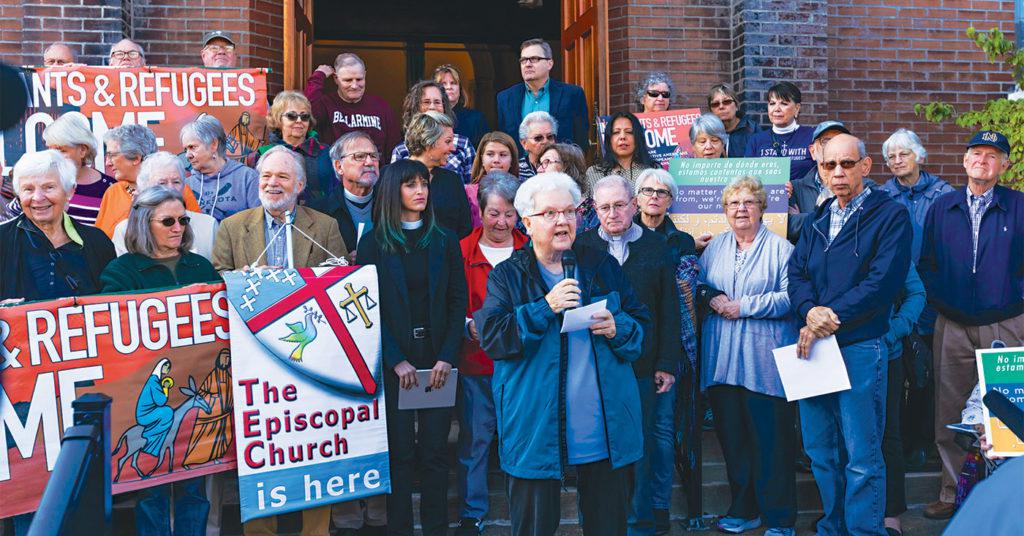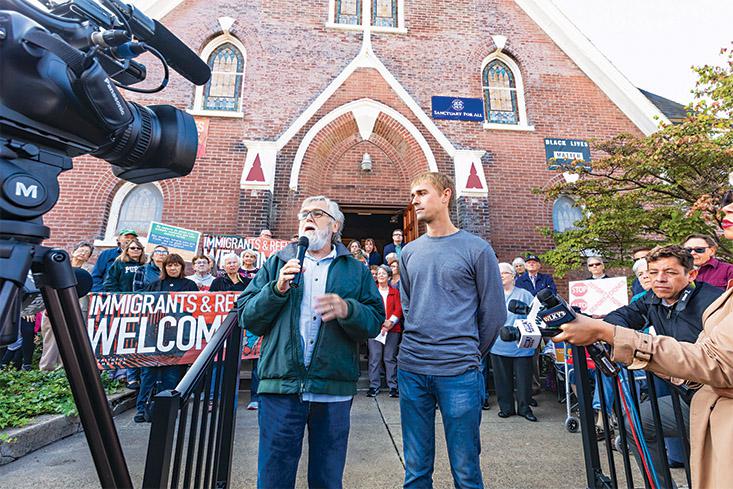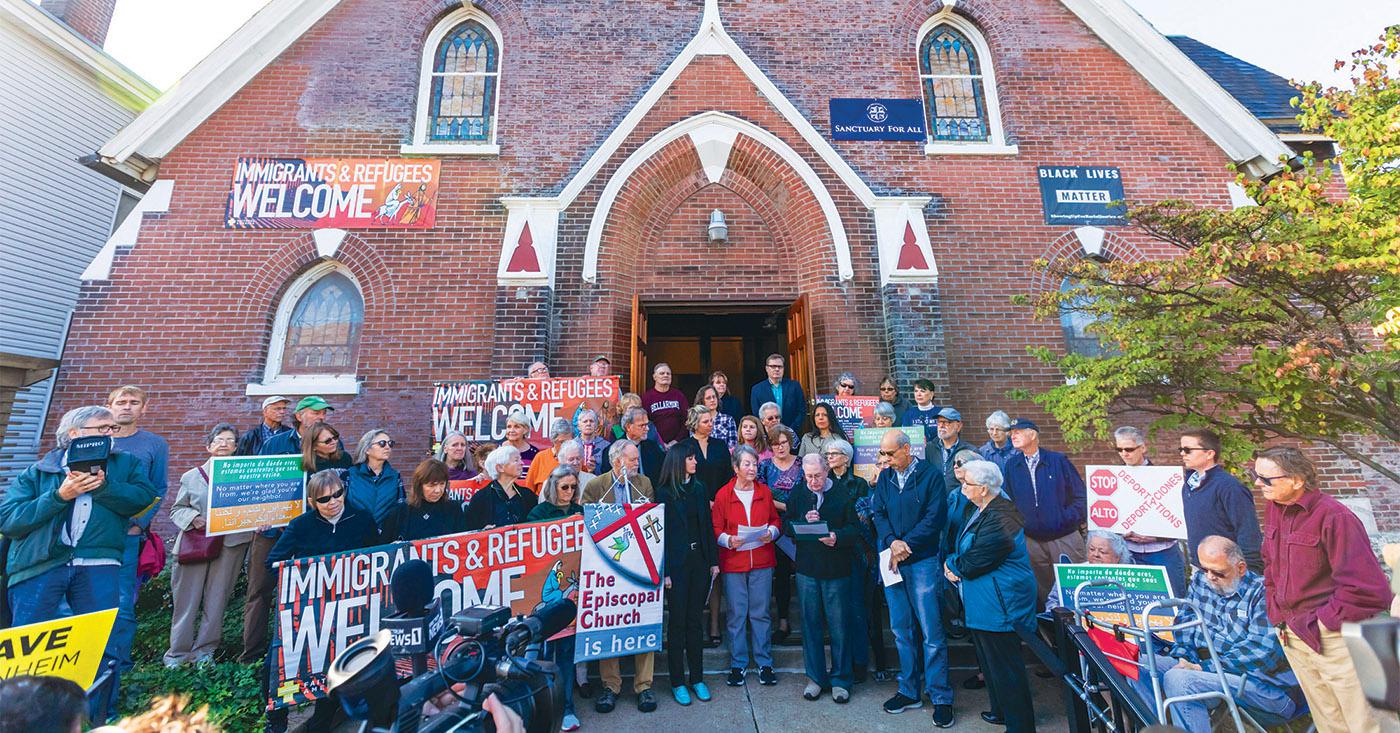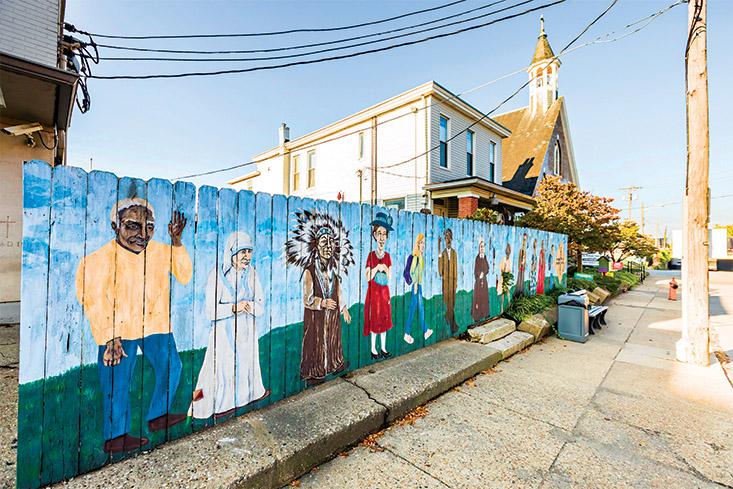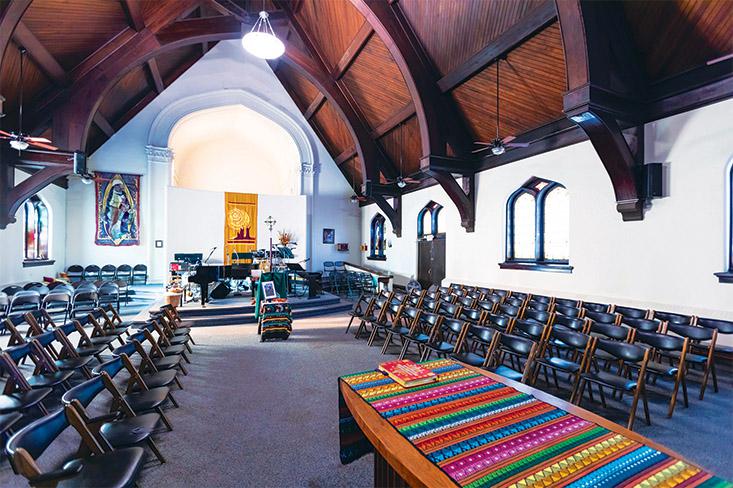|
For A Different Kind Of Catholic: St. William’s Activism, Unorthodox Practices
By Danielle Grady
Members of St. William Catholic Church stood shoulder to shoulder on the steps of their Park Hill church, holding signs and banners declaring: “Refugees and Immigrants Welcome.” “This morning, we reaffirm our long-standing commitment as a sanctuary parish,” Dawn Dones, the pastoral associate for St. William, told a huddle of TV cameras and reporters. With that, St. William, located at the corner of 13th and Oak streets, became the first Catholic church in Louisville in recent times to publicly declare itself a sanctuary, but the parish has had many firsts. St. William has long been known as an advocate for progressive, social justice causes, despite — and sometimes at odds with — the often-conservative nature of the Roman Catholic Church. The congregation’s activism goes back to the ‘60s when it opposed the war in Vietnam and began advocating for fair housing. Since then, the parish has voiced support for other groups and causes, such as Black Lives Matter. “We believe in what we’re doing. We’re not bashful about it,” said Bob Eiden, a member of the church since the 2000s. “Plus, we’re the progressive center for Louisville.” This forward-thinking spirit is represented in the way St. William is run and in the way it performs its Masses, as well. The parish is the only one in the Archdiocese of Louisville to be headed by a pastoral administrator (and a woman, at that) instead of a male priest. Decisions are made by the congregation as a whole, instead of being handed down unilaterally by its leader. And during Mass, norms are broken, including the use of gender-neutral language throughout the ceremony, not kneeling during the Eucharistic Prayer and reflections given by congregation members over Bible readings instead of a homily from the priest. “We are a viable expression of Catholicism,” said Joe Grant, the peace and justice formation minister for St. William and member of its pastoral leadership team. “Because we do things a little bit differently, it doesn’t mean that we’re heretical. It just means that we’re trying to be authentic to how we feel called through our baptism and through our community gatherings, through the Gospel that we read every Sunday — to respond and engage, not just as individuals, but together. “ St. William has played a special role within the Archdiocese of Louisville and for the city’s 160,000 Catholics — providing a home to progressive followers, some of whom previously considered leaving the Church. But what has attracted fringe Catholics to St. William has also occasionally put the parish at odds with the Archdiocese, particularly over the parish’s traditions and organization. Parish leadership called its intermittent standoffs with the Archdiocese “creative tension.” “I’m very grateful for the Archdiocese, because they’ve always openly worked with us, and I have always felt that,” said Sharan Benton, St. William’s pastoral administrator. The Archdiocese declined an interview with LEO for his story but issued a statement: “The Archdiocese of Louisville has 110 parishes in 24 counties of Kentucky. These parishes are unified under the Archbishop as the local Church of Central Kentucky and are united in following the teachings and rituals of the Roman Catholic Church. Within this unity, each parish, including Saint William Church, brings unique gifts to our local Church. We are especially grateful to the parishioners of Saint William for their embrace of Catholic social teaching and their generous response to those in need.” With such conciliatory words on both sides, you would hardly know that, in June, a disagreement threatened to split the parish from the Archdiocese entirely. St. William had to decide what did it want more: To stay in the church, or to preserve its administrator-led leadership structure, both of which the parish holds dear. The Archdiocese acquiesced, releasing the tension and halting any talks of separating, which have yet to resurface — for now. A VATICAN II STORYSt. William started in 1901 as a typical Louisville, Catholic parish. Its members were Irish immigrants employed at the rail yards surrounding the church, according to Joseph Martos, a 27-year member of St. William and a theologian who has worked at Bellarmine and Spalding universities. Necessity would push St. William to its current progressive identity. As the railroad industry changed, St. William’s membership dipped drastically in the 1960s. Its school closed, and the parish was about to do the same— until Vatican II happened. This meeting of Catholic bishops resulted in an about-face for how the Roman church connected with people beyond its gilded compound. Catholicism, then-infamously insular, not only became a church of the world but one that encouraged active participation from its congregants, which was most vividly represented by a new rule allowing the Mass to be celebrated in the languages of its people, not just in the traditional and antiquated Latin. St. William, the Archdiocese decided, would be the petri dish for Vatican II in Louisville. The parish would embody the new mindset, and a young priest, the Rev. Ben O’ Connor would lead the way, said Grant. Membership quickly rose. People were drawn to its mission, which was to get congregants more involved in the church, its services and the world community with a focus on peace, justice and service, said Grant. This led to charitable works. Under O’Conner, the parish was the birthplace of New Directions Housing Corp., a now-independent Louisville nonprofit that provides affordable housing to over 1,000 families. Today, St. William is a large donor to St. Vincent de Paul, and it contributes tens of thousands of dollars a year to a sister parish in Nicaragua for an organic farming initiative and medical clinic. The new mission also meant political engagement. During the Vietnam War, St. William publicly opposed the conflict by becoming a“peace parish.” After the Rev. Jim Flynn took over the parish in the 1980s, St. William became a sanctuary church, accepting families from El Salvador and Guatemala into its rectory. The sanctuary movement of the ‘80s involved churches across the United States sheltering Central American refugees in their buildings to protect them from being deported by the federal government. At the time, U.S. backed regimes in Central America were causing discord and giving rise to paramilitary groups, and the American government considered immigrants from the area to be illegal aliens. During this time, Flynn became one of Kentucky’s most outspoken opponents to U.S. intervention in Central America. St. William continues its pro-immigrant tradition today, recently, in its reaffirmation as a sanctuary church. The journey to this announcement highlights the sensitive relationship St. William has with the Archdiocese. The parish originally wanted to re-declare sanctuary in 2017, but the Archdiocese at first urged caution, asking St. William to consider the legal consequences, members of parish leadership said. Unlike the sanctuary movement of the 1980s, being a sanctuary church today doesn’t necessarily mean housing immigrants on church property. Instead, a sanctuary church is one that supports asylum seekers, said David Horvath, a member of St. William’s immigrant-led support ministry. That could mean through monetary donations, legal counsel, rides to appointments or help with housing. Under pressure from the Archdiocese, St. William walked back from publicly announcing sanctuary in 2017, but it started to quietly work on immigrant support efforts, donating $45,000 to the Louisville Latinx advocacy organization, the La Casita Center, to fund two staff positions and helping to establish an Interfaith Coalition for Immigrant Justice — a network of local churches and other places of worship dedicated to helping immigrants. Some congregation members even took in immigrants, parish leadership said. Supporting immigrants also meant backing the local Occupy ICE movement and Mijente Louisville’s Sanctuary for All push, pressuring Louisville’s government to declare itself a sanctuary city. Neither Metro Council nor Mayor Greg Fischer ever did so, although the city did pass an ordinance stopping local law enforcement from cooperating with ICE agents under certain circumstances. St. William decided to label its sanctuary efforts this year. And, this time, the Archdiocese backed the parish fully. At the Oct. 8 announcement, Dones read a letter of support from the Archdiocese. “St. William is communicating today about its plans to assist immigrants and refugees,” the statement said. “Much of this corresponds to the priorities of our local Church and long-standing efforts by the United States Conference of Catholic Bishops.” The letter went on to encourage all parishes in the Archdiocese of Louisville to “respect the dignity” of people seeking a better life and those fleeing violence and persecution. The words were met with vigorous applause. Today, sanctuary at St. William no longer means housing immigrants and refugees for long periods. Instead, the parish wants to continue working with immigrant-led groups and other churches, which might include short-term shelter for immigrants in emergency situations. A “Sanctuary for All” banner now hangs on the church for everyone who passes to see. NO PRIEST IN CHARGEIn the 1990s, spurred by a priest shortage, the former Archbishop Thomas Kelly appointed the first lay person — not a priest — as St. William’s leader. A priest would stay on, but only to perform Catholic duties that lay people are restricted from: turning the bread into Jesus’ body and the wine into his blood during Mass and performing the other sacraments, including baptisms, marriages and confessions. Today, Benton is St. William’s pastoral administrator, and the Rev. John Burke is the parish’s priest, who takes on the role of sacramental minister. The parish leadership team handles day-to-day responsibilities and communication with the Archdiocese. Seventeen to 18 community ministries, each with a different area of expertise, such as immigrant-led support, make decisions in their respective fields. But, all major issues are taken before the entire, 300-person congregation to be decided on “consensus.” It’s this organizational structure, particularly the role of the pastoral administrator, that further cemented St. William as a Vatican II parish — one completely devoted to the idea that the congregants, not the bishops or priests, are the heart of the Catholic Church. Under it, even more charitable efforts took root, according to Martos: Just Creations, a store selling fair trade goods, and CrossRoads Ministry, which creates religious retreats that teach participants how to make a difference in marginalized and diverse communities. It’s St. William’s structure that keeps its congregants coming, Dones said. “We know this structure for governance works: The pastoral administrator and the sacramental moderator [priest],” Dones said. “And, it’s not just worked, the community has thrived under that model for more than three decades.” LAST CHANCE FOR CATHOLICSOn the way out of Jefferson County, there used to be a liquor store called Joe’s Last Chance, a final opportunity to buy a drink before hitting a dry county. At least, that’s what a priest visiting St. William told Art Baltes, a member since 1996. For Catholics, St. William was their Joe’s Last Chance, the priest said — the last parish they tried before deciding whether to leave the Church. “There are people that have tried and tried, either by staying in the closet or by keeping their mouths shut or whatever, tried to stay in the Church,” said Baltes. “And they’ve had people give sermons saying that what they were doing — they were sinning. It was wrong. And they would eventually leave and join another church… If you can’t fit into any other church in the Archdiocese, then St. William might be your last chance.” It’s an increasingly important role in a religion in which only 63% of adherents belong to a parish, according to a Gallup poll — a 13% reduction over the last 20 years. Protestant churches also have lost members, but a smaller percentage. Sixty-seven percent of Protestants are members of a church, down 6% from 1998 to 2000. St. William welcomes LGBTQ members, including those who are married. It encourages women to participate, extending to its highest office. You won’t hear anything in their sermons degrading members for their gender or sexual orientation. This appeals to members such as Eiden, a cradle Catholic who said, for him, it was either St. William or Buddhism. The native Louisvillian had attended a progressive church in California before returning to his home city. Here, he tried other Catholic churches, but he became tired of how male dominated they were, the sex scandals and the conservatism of the pope at the time, John Paul II. And, then, he sat through a particularly dry homily from his deacon. “That’s the last time you bore the shit out of me,” Eiden recalled saying to himself on his way out the door. The week after leaving his parish, Eiden found himself at St. William. He stayed because he liked the parish’s progressiveness — the fact that he could stand up at Mass and talk about social justice — and the charities that the parish supported. It felt fresh, he said. Baltes, another cradle Catholic, attends St. William because of its activism. “Churches have got to step outside their doors and do something in this world,” he said. Parish leadership say all are welcome at St. William. But some conservative Catholics might not feel comfortable there. SOCIAL JUSTICE EN MASSEAt a service on July 28, even the reflection — given by St. William member Karina Barillas — was peppered with political references, and not your typical, Catholic fare, such as abortion and peace to the world. “How do you explain to the poor, the oppressed, the children in the cages at the border — the person who has a beloved one that is dying — that their prayers will be responded to eventually — but that they have to keep on asking and praying and believing that the suffering will pass and that their prayers will be answered?” Barillas, who is the executive director of the La Casita Center, asked the church. Later, the congregation prayed as a whole for transgender migrants at the U.S. Mexico border, Palestinians in the Middle East and an end to the death penalty. They used gender-neutral language during the Mass, a St. William tradition since the ‘80s. Instead of referring to God as a “father” or even “mother,” for example, congregants said “creator” and “maker.” Parish leadership members said they are following “Catholic social teaching” with their advocacy. According to the United States Conference of Catholic Bishops, Catholic social teaching involves seven themes, including the life and dignity of humans; help for the poor and vulnerable; the dignity of work and the rights of workers; and care for God’s creation. Dones said St. William’s social justice work comes from its belief in Jesus. “We are who we are because we are faithful people,” she said. “And our faith has provided us a guide, and so we look at the Gospel and the teachings of Jesus as this pervasive example of how we can live and who we can be and the way the world could be.” FORMALITY GOES OUT THE STAINED GLASS WINDOWAt that same July service before the Mass had begun, congregation members milled about, shaking hands and doling out hugs to people they knew and others they recognized as newcomers. The parish band delivered a peppy soundtrack with a drum set, keyboard and other instruments. At St. William, pomp is not tolerated. The parish’s altar is not at the front of the church building, as most are, but in the middle — surrounded by rows of folding chairs. The priest does not march in a processional to the front of the church, but rather, sits in a chair like everyone else, standing up when needed. At most parishes, the Sign of Peace portion of the Mass is a brief moment when those sitting next to each other shake hands. At St. William, congregants becomes mobile, traveling across the aisle to embrace and say a few words to their neighbor. It can last 10 minutes. Not all Catholics are going to like this. “And we understand that — it’s not for everyone,” said Grant. “But it is for some. And all we’re saying is, let it be as it is for some.” REBEL CHURCH OR JUST DIFFERENT?As different as St. William appears, parish leadership would say that the congregation is just as Catholic as any other parish in the Church. “We’re maybe liturgically distinct, but it’s not liturgically defiant,” said Grant. Martos, the theologian, said St. William does not break the rules of the Catholic Church: “We bend them.” For example, canon law, the rules that govern the Catholic Church, say that priests are supposed to give sermons based on the weekly Scripture readings, called homilies, at every Mass. It is a practice that’s to be omitted only in “grave circumstances.” At St. William, lay people often give reflections on the readings instead. But Martos pointed out that canon law also allows bishops, such as the Archdiocese of Louisville’s Joseph Kurtz, to give priests the permission to arrange for other types of preaching, which has happened in St. William’s case. There are some rules that St. William will not break, even when adhering to them may be at odds with the parish’s progressive nature. Dones, the pastoral associate, said that marriages performed within St. William have to be sacramental, Catholic marriages, but she did not respond to LEO’s question about whether St. William performs same-sex marriages. Martos said that the parish does not perform marriages for same-sex couples, although it has recognized them on anniversaries or after a couple has gotten married somewhere else. The parish fiercely defends the iconoclastic practices it does partake in. Several years ago, Kurtz issued mandates to parishes throughout the Archdiocese, asking them to implement certain changes if they weren’t already following them. Kurtz is a more conservative archbishop than has ruled over the Archdiocese in the past, said Martos. He was appointed by post-Vatican II popes John Paul II and Benedict XVI, first to a position as Bishop of Knoxville, Tennessee, and then to his current station. St. William’s reaction to Kurtz’s mandates were documented in a chapter of “Worship as Community Drama: Introduction to Liturgy Evaluation,” a book by the sociologist Pierre Hegy. The mandates targeted practices sacred to St. William, including one directive that would have barred lay people there from preaching. Instead of accepting the mandates without question, St. William debated them as a congregation — a process that took two years, according to Hegy, who interviewed several congregants. Eventually, the parish decided that it was already following several of the mandates. It comprised on some, while fully rejecting others. One compromise was on the topic of lay preaching. The congregation refused to stop giving reflections but gave into an Archdiocese request that it leave reading the Gospel beforehand to the priest. Parish leadership told LEO they informed Archbishop Kurtz about their decisions, stressing that they wanted to remain a part of the Archdiocese and that they thought his mandates were more of a challenge than a gift to St. William. In the case of another mandate, to kneel during the Eucharistic Prayer (when the bread and the wine are transformed), St. William decided it didn’t want to spend money on the necessary kneelers, funds that could be going to charity, Martos said. “Plus, the fact that we’re obstinate,” he added. Kurtz did not overrule the parish’s decisions. The leadership asserted that by Vatican II standards, St. William is very much in line with the wider Catholic Church. Even the current pope, Francis, has said that there are still lessons to be learned from the Second Vatican Council. “In one way, we might be seen as an outlier in terms of our model, but in another way, it’s very consistent, not only with Vatican II, but with the orientation of the current pope,” said Andrew Stone Porter, another member of the parish leadership team and St. William’s music minister. Benton said St. William has a good relationship with and maintains good communication with Kurtz. “If I called him and said, I need to talk to you, within 10 minutes I had a phone call from him,” she said. After the mandate debate, all seemed calm between the two parties. But that changed as Benton neared her retirement. A SPLIT AND A STITCHThe decision that St. William’s leadership faced in June seemed impossible: Give up their beloved organizational structure or defy the Archdiocese, perhaps severing their tie forever. It started after Benton was asked to retire after 22 years at St. William. At a certain age, its common practice for people within the Archdiocese to retire, said Dones, and Benton was 75. At one point, there were seven lay administrators working within the Archdiocese of Louisville, parish leadership said. Now, St. William is the only one. And, instead of replacing Benton with a new pastoral administrator and keeping the tradition going, Kurtz announced that he’d be sending a priest and a deacon to the parish, according to leadership and several congregation members. The priest and deacon were more conservative than St. William. Congregation members told LEO that the priest and deacon proposed changes to the parish including: No more center altar, the installation of a confessional and, most offensive, final say in all decisions. St. William balked. After meeting with the priest and deacon, congregation members held a parish assembly. They were presented with a poster that outlined different options for the parish: Let the priest take over, let him take over but re-evaluate the situation after a few months, negotiate with the Archdiocese or leave the Catholic Church altogether to become an independent Catholic community, separate from Rome and the Archdiocese. Congregation members were given stickers and told to place them on the options they liked. The dots weren’t counted at the meeting, but two congregation members told LEO that a large number appeared to be in favor of leaving the Catholic Church. Leadership members felt tortured. Whichever way, St. William would not be the same. Without a pastoral administrator, they feared an exodus. “We knew that this wouldn’t work,” said Grant. “We knew that we would either die in very quick order or we would simply whittle down to not being the community we were.” At the same time, the leadership and other congregation members were unwilling to separate from the Catholic Church. “Catholicism is in our bones,” said Grant. “It’s who we are.” Some congregants, such as Eiden, wouldn’t have minded separating from the Church. But others, among them Baltes, were hesitant. Splitting from the Church would mean losing the building. “My personal opinion was this,” Baltes said. “We need to stay put at 13th and Oak. We’re part of the neighborhood. We pay bills in the neighborhood. We help people… I didn’t want to move out of the neighborhood, and I wouldn’t want to give up the ship.” So, Benton did what she’s done with the Archdiocese many times before: She picked up the phone to speak with Kurtz. Three days after the parish assembly, the congregation learned that the Archdiocese had pulled back. It withdrew the priest and deacon and told Benton she could stay on for another year. It was “the miracle on 13th Street,” said Baltes. As of October, Benton has eight months left. She believes that the issue will come up again, but she hopes that another conversation can occur.“And the archbishop has already said we would have dialogue and conversation to see how can we best meet the needs of St. William,” she said. It was during this period of turmoil, however, that St. William decided to reaffirm its role as a sanctuary church. St. William might have already been engaging in sanctuary-like activities, but announcing its efforts to the world was important for some congregants. “People look at us to be the positive leaders of Louisville,” Eiden said. It’s not clear why the Archdiocese decided to allow St. William to keep its leadership structure. Eiden speculated that it had to do with Kurtz’s health. (The archbishop is undergoing cancer treatment). Horvath thought it was because the Archdiocese recognized that St. William plays an integral role in the organization with its activism and community involvement. The parish is special, leadership said. “We’re not trying to be polemic, and we’re not trying to be boastful, we’re not trying to say we’re better than any other parish and we do everything the way everything should be done,” said Grant. “But we do want to say we offer a distinct and unique set of gifts to the diocese.
|
.
Any original material on these pages is copyright © BishopAccountability.org 2004. Reproduce freely with attribution.
